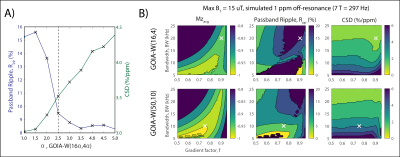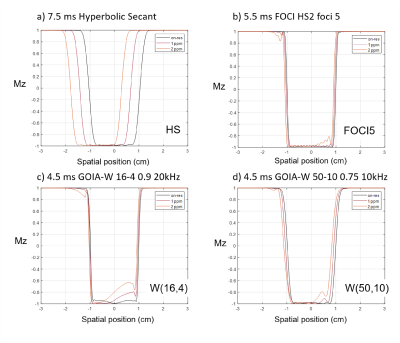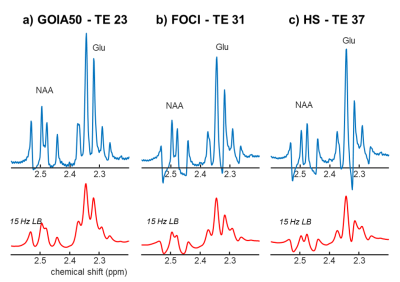1988
GOIA-WURST optimisation for ultra-high field single-voxel MRS at short-TE1Sir Peter Mansfield Imaging Centre, School of Physics and Astronomy, University of Nottingham, Nottingham, United Kingdom, 2Russell H. Morgan Department of Radiology and Radiological Science, Johns Hopkins University School of Medicine, Baltimore, United Kingdom, 3F.M. Kirby Research Centre, Kennedy Krieger Institute, Baltimore, MD, United States, 4Danish Research Centre for Magnetic Resonance,Centre for Functional and Diagnostic Imaging and Research, Copenhagen University Hospital, Hvidovre, Denmark
Synopsis
Gradient modulated pulses allow for accurate slice localisation in single-voxel MRS. However, they suffer from ‘smearing’ artifacts at off-resonance leading to poor performance across the inversion band, particularly when B1 field strength is low. An optimized GOIA-WURST pulse shape was found by simulating changes in the modulation parameters to improve the off-resonance profile at 7T for B1 of 15 μT. When used in a semi-LASER localisation, the optimised GOIA(50,10) pulses resulted in a minimum TE of 23 ms which led to upright peak shapes for J-coupled multiplets in phantom.
Introduction
Adiabatic refocusing pulses have found widespread use in single-voxel MRS due to their low chemical shift displacement (CSD) and robustness to B1 inhomogeneity. Gradient modulated shapes such as GOIA and FOCI1,2 provide even lower CSD. However, ‘smearing’ artifacts are often observed for off-resonant slices using gradient-modulation3 leading to increased out-of-voxel excitation and signal-variation across the slice. This is worsened when B1 levels are limited and short pulse durations are required to minimize TE for quantification of coupled metabolites4. In this work, we optimized modulation parameters for GOIA-WURST2 specifically to find optimal inversion with short duration pulses and robustness to off-resonance at a low B1 level at 7T.Methods
Simulations of GOIA-W(n,m) pulses were carried out to optimise off-resonant inversion. Changes to the order of B1 (n) and gradient (m) modulations, the pulse bandwidth (BW), and gradient factor (f) were made. The pulse duration was constrained to 4.5 ms. Off-resonant behaviour was implicitly optimised by simulating at +1 ppm (297 Hz at 7T). The maximum B1 was fixed at 15 μT. Bloch simulations were conducted in MATLAB (The Mathworks, Natick, MA) for a nominal slice profile of 2 cm (±10 cm, Np = 1000). To quantify performance, the average longitudinal magnetisation in the passband, $$$M_{z,avg}$$$, passband ripple, $$$R_{pp}$$$ (= maximum-minimum $$$M_{z}$$$) and CSD (%/ppm = ratio of profile shift to voxel size) were calculated similar to a recent 3T study5.Initial (n,m) estimates were made by incrementing by factor α, where W(16α,4α) (Fig. 1A). Subsequently, BW and f were varied over 5-25 kHz and 0.5-0.95, respectively, on a 50x50 grid. The simulated profiles were compared to (i) a GOIA-W(16,4) modulation (f=0.9, BW=20 kHz, dur=4.5ms) (ii) a hyperbolic secant pulse (HS) (TBP=12.5, dur=7.5ms) and (iii) a previously used HS-2 pulse with FOCI modulation (FOCI5) (FOCI factor = 5, HSn=2, dur=5.5ms)6.
MRS data were acquired on a SPECTRE brain metabolite phantom (Gold Standard Phantoms, UK), containing NAA, Choline, Creatine, Glutamate, GABA, Lactate and water. A semi-LASER sequence was used with an asymmetric excitation pulse, DOTCOPS7 crusher gradients and three adiabatic refocusing pulses: GOIA-W(50,10), FOCI5 and HS, leading to minimum TEs of 23 ms, 31 ms and 37 ms, respectively. Pulses were operated at a maximum B1 of 18 μT, i.e. 20% overdrive for the design of the GOIA-W(50,10).
Results
Fig.1A shows the effect of increasing α on $$$M_{z,avg}$$$ and $$$R_{pp}$$$. Beyond W(16,4) (α=1) there was an improvement in $$$R_{pp}$$$, however CSD also increased. A value of α=2.5 was determined as a trade-off between CSD and high $$$R_{pp}$$$ (> 10 %). Fig. 1b plots the performance-metrics for GOIA-W(16,4) and the empirically determined GOIA-W(50,10), which was slightly adjusted from α=2.5. No combination of BW and f resulted in $$$M_{z,avg}$$$ < -0.95 for the W(16,4) pulse. However, for W(50,10), $$$M_{z,avg}$$$ < -0.98 was achieved with low $$$R_{pp}$$$ (< 10 %). To keep CSD <= 4 %/ppm, BW = 10 kHz and f = 0.75 were selected.Fig. 2 shows simulated profiles for the HS, FOCI5, GOIA-W(16,4) and GOIA-W(50,10) pulses at 0, 1 and 2 ppm. HS showed relatively large CSD; FOCI5 showed a good slice profile but at 5.5 ms; GOIA-W(16,4) shows undesirable ‘smearing’, whereas GOIA-W(50,10) shows a compromise between CSD and off resonance smearing. Excellent spectral quality was achieved using GOIA-W(50,10) pulse (Fig. 3) in phantom comparable to HS and FOCI5 pulse shapes (Fig. 4). The minimum TR due to SAR restrictions for sLASER, including VAPOR water suppression, was found to be 2900, 3371 and 1428 ms, for GOAI-W(50,10), FOCI5 and HS, respectively. At 15 μT, the minimum TR fell to 2090 ms using GOIA-W(50-10). The multiplets of glutamate and NAA exhibited an upright line-shape at TE = 23 ms (Fig. 5).
Discussion
A GOIA-WURST(50,10) pulse was found to perform better for off-resonance at low B1-field strengths than traditional GOIA-W(16,4) pulses at 4.5 ms. By increasing the order of modulation, inversion had a reduced smearing artifact (Fig. 2). Outer voxel excitation was also reduced (Fig. 2) even at 2 ppm. However, GOIA(50,10) had a larger CSD (4%/ppm) equal to a recent maximum recommended value [8]. The sharpness of the slice profile was sacrificed for improved off-resonance behaviour.Spectra were comparable to those acquired using longer FOCI pulses, yet allowed for a shorter TE (of 23 ms) and reduction of TR for 7T. Shorter TEs can lead to improved quantification especially for low-concentration J-coupled metabolites. Future work will verify the pulse performance in vivo for metabolite quantification. The optimized GOIA-W(50,10) shape may be advantageous when B1 availability is limited at ultra-high-field and can be used in other adiabatic sequences such as LASER, SPECIAL or for MRSI.
Conclusion
An optimized GOIA-WURST pulse was found to result in less off-resonant ‘smearing’ at 15 uT and reduced the minimum TE of semi-LASER to 23 ms at 7T.Acknowledgements
The Danish national 7T scanner was donated by the John and Birthe Meyer Foundation and The Danish Agency for Science, Technology and Innovation (grant no. 0601-01370B). The authors would also like to acknowledge the Precision Imaging Beacon, University of Nottingham.References
1 A. Tannús and M. Garwood, “Adiabatic pulses,” NMR Biomed., vol. 10, pp. 423–434, 1997.
2 O. C. Andronesi, S. Ramadan, E. M. Ratai, D. Jennings, C. E. Mountford, and A. Greogry Sorensen, “Spectroscopic imaging with improved gradient modulated constant adiabaticity pulses on high-field clinical scanners,” J. Magn. Reson., vol. 203, no. 2, pp. 283–293, 2010.
3 B. A. Hargreaves, C. H. Cunningham, D. G. Nishimura, and S. M. Conolly, “Variable-rate selective excitation for rapid MRI sequences,” Magn. Reson. Med., vol. 52, no. 3, pp. 590–597, 2004.
4 K. Landheer, M. Gajdošík, and C. Juchem, “A semi-LASER, single-voxel spectroscopic sequence with a minimal echo time of 20.1 ms in the human brain at 3 T,” NMR Biomed., vol. 33, no. 9, pp. 1–12, 2020.
5 D. K. Deelchand et al., “Across‐vendor standardization of semi‐LASER for single‐voxel MRS at 3T,” NMR Biomed., no. October, p. 49, Dec. 2019.
6 C. S. Arteaga de Castro et al., “Improved efficiency on editing MRS of lactate and γ-aminobutyric acid by inclusion of frequency offset corrected inversion pulses at high fields,” NMR Biomed., vol. 26, no. 10, pp. 1213–1219, 2013.
7 K. Landheer and C. Juchem, “Dephasing optimization through coherence order pathway selection (DOTCOPS) for improved crusher schemes in MR spectroscopy,” Magn. Reson. Med., vol. 81, no. 4, pp. 2209–2222, 2019.
8 M. Wilson et al., “Methodological consensus on clinical proton MRS of the brain: Review and recommendations,” Magn. Reson. Med., vol. 82, no. 2, pp. 527–550, Aug. 2019.
Figures




